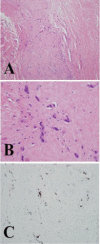Angiosarcoma of the seminal vesicle: a case report of long-term survival following multimodality therapy
- PMID: 24711908
- PMCID: PMC3977171
- DOI: 10.4081/rt.2014.5202
Angiosarcoma of the seminal vesicle: a case report of long-term survival following multimodality therapy
Abstract
Angiosarcoma of the seminal vesicle is an extremely rare malignancy, with few published case reports in the literature. We present a case of primary angiosarcoma of the seminal vesicle in a 45-year-old male who was treated with multimodality therapy, consisting of neoadjuvant chemotherapy and chemoradiation followed by surgical resection and intraoperative radiation therapy. He has been free of cancer recurrence for more than six years after completion of therapy. To our knowledge, this represents the longest reported survival of a patient with this rare tumor, and one of the few cases reported using a multimodality therapy approach.
Keywords: angiosarcoma; chemoradiation; neoadjuvant; prostate; seminal vesicle; surgery; trimodality therapy.
Conflict of interest statement
Conflict of interests: the authors declare no potential conflict of interests.
Figures


References
-
- Mendenhall WM, Indelicato DJ, Scarborough MT, et al. The management of adult soft tissue sarcomas. Am J Clin Oncol 2009;32:436-42 - PubMed
-
- Maddox JC, Evans HL. Angiosarcoma of skin and soft tissue: a study of forty-four cases. Cancer 1981;48:1907-21 - PubMed
-
- Chan KW. Angiosarcoma of the prostate. An immunohistochemical study of a case. Pathology 1990;22:108-10 - PubMed
-
- Chandan VS, Wolsh L. Postirradiation angiosarcoma of the prostate. Arch Pathol Lab Med 2003;127:876-8 - PubMed
Publication types
LinkOut - more resources
Full Text Sources
Other Literature Sources

